Calatheas are the most beautiful houseplants due to their eye-catching and elaborate foliages. It comes in many varieties with distinct features. This guide will help you learn about the different calathea varieties.
My favorite calathea varieties are orbifolia, makoyana, ornate, zebrina, rufibarba, crocata, marantifolia, and lancifolia. These types of calathea are easy to grow and maintain regardless of an individual experience.
Take the time to read through this list of calathea varieties with pictures for easy identification and provision of ultimate care. The calathea identification information will help you make an informed decision before adding any to your indoor plant collection.
You May Also Like: Why Are My Calathea Leaves Turning Yellow?
Different Calathea Types to Grow and Collect
Calathea Orbifolia
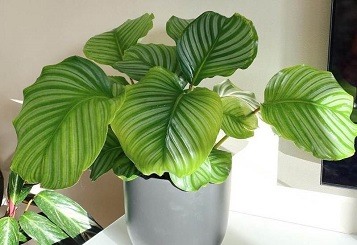
Orbifolia is not among the rare calathea varieties. The species is ideal for making a bold statement in any space. Thanks to its large robust foliages with metallic patterns.
The green foliages are round and leathery with streaks of silver patterns. These leaves grow up to 12-inches wide and a mature plant can reach 12.5 feet tall.
The thick and bushy appearance with new growths emerging from the plant centers helps to bring a tropical vibe at home or office.
Calathea orbifolia care involves a high humidity level and temperature range of 65-85oF. The humid and warm environment allows the houseplant to thrive.
Keep the orbifolia species away from heat and cold draft. Besides that, consider using water-soluble houseplant fertilizer once during the growing season.
You Can Also Read More: How to Care for Calathea Orbifolia
Calathea Warscewiczii
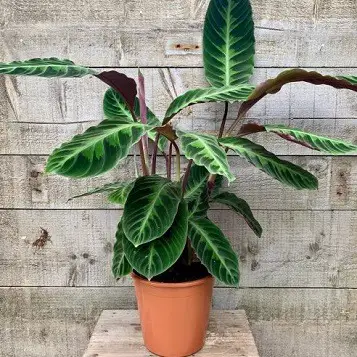
Warscewiczii is a soft herbaceous perennial evergreen native to Costa Rica and Nicaragua. It is my favorite and among the most popular calathea varieties.
The calathea species is named after Jozef Warwscewiczii (a difficult name to pronounce). Thank God, it is also known as Calathea Jungle Velvet.
The lance-shaped velvety and dark green foliages with light green banding make this species superior to others. The rich purple undersides with fishtail patterns are incredible.
A mature plant grows up to 3 feet tall with leaves 12-inches wide. The houseplant tends to fold its leaves in the evening like those in the prayer plant family.
Calathea Warscewiczii care entails well-draining soil, temperature range 65-80oF, and high humidity requirement. Keep the calathea away from cold and heat drafts.
You May Also Read: How to Care for Calathea Warscewiczii (Jungle Velvet)
Calathea Makoyana
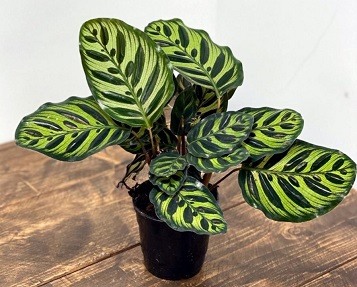
The calathea type is also known as peacock plant or Cathedral window. The colorful egg-shaped foliages are the reason behind the calathea identification.
The papery thin foliages have light green with dark green peacock markings and purple undersides. The leaves grow up 12-inches long with each leaf attached to a reddish-pink stem.
Juvenile leaves are rolled to highlight their purple undersides. The calathea species has a low-growing profile to bring a compact appearance. It grows up to 12-inches tall.
Calathea makoyana care consists of well-draining soil, appropriate watering routine, high humidity, and a temperature range of 60-70oF. Use water-soluble fertilizer to feed the plant.
Calathea Crocata
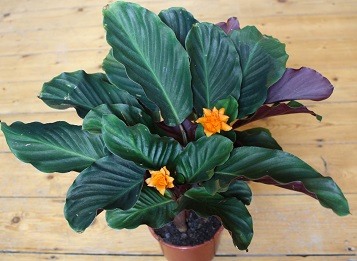
It belongs to the rare calathea varieties. The species is also known as Eternal Flame due to its eye-catching and robust flowers. The calathea type is native to Brazil jungle or rainforest.
The beautiful flowers have bright yellow or orange colors with spikes rising. The rising spikes mingle with the wavy spear-shaped foliages. The flowers last for two-three months indoor.
A mature crocata grows up to 1-2 feet tall and wide. It thrives in a warm and humid environment with ease. The plant loves a temperature range of 65-85oF.
Avoid growing the houseplant in a damp environment to prevent root rot issues. Besides that, keep the calathea species in bright indirect sunlight.
Calathea Ornata
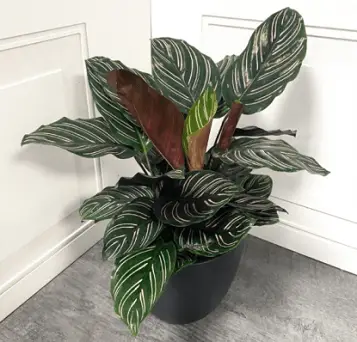
The calathea type is also known as the Pin-Stripe Plant. Thanks to the ornately stripe leaves that make the species belong to calathea varieties pink.
Ornata species is native to Ecuador and Colombia. It is among the most popular types of calathea in the United States and Canada.
The dark green and shiny oblong leaves with purple undersides make the species stand out from others. Each leaf is attached to a long green stem.
The pinkish-white pins on the foliages make a bold statement at home or office. The leaves grow up to 2 feet tall and wide to bring that tropical vibe.
Calathea ornata care is composed of a well-draining potting medium, frequent watering, high humidity, and a temperature range of 65-80oF. Place the houseplant in bright indirect sunlight.
You May Also Enjoy: Why Is My Calathea Dying?
Calathea Zebrina
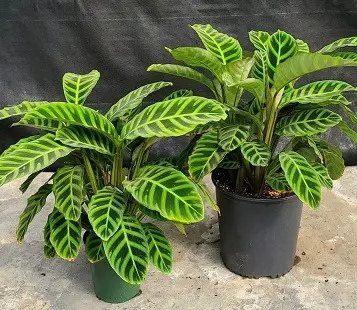
It is a perennial plant native to Southeastern Brazil. The calathea type is also known as the zebra plant making it easier to identify from various calathea varieties.
The zebra plant name comes from the striking light green and velvety leaves with purple undersides. The dark green stripes running across the leaves resemble the Zebra animals.
Each leaf grows up to 12-inches long and wide. Besides that, the calathea species usually fold the leaves at night. A mature zebrina grows up to 2-feet tall and wide.
Provide good calathea zebrina care for successful growth. The plant loves well-draining soil, high humidity, and a temperature range of 65-80oF.
Keep the houseplant away from cold and heat drafts. Besides that, provide medium to bright indirect sunlight to enhance better growth.
Calathea Lancifolia
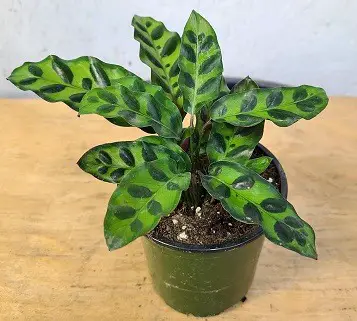
The species is also known as the Rattlesnake plant due to the unique foliage markings that resemble a reptile. It is the tallest calathea variety that grows up to 18-inches tall.
The long lance-shaped and glossy leaves have pale to yellowish-green surfaces with purple undersides. The dark green blotches on both sides make the houseplant adorable.
Calathea lancifolia rarely bloom when grown indoors. But outdoor lancifolia produce yellow flowers in spring that matches its attractive foliages.
Rattlesnake plant care involves the provision of well-draining soil, high humidity, bright indirect sunlight, and a temperature range of 65-75oF. Feed the plant often in spring and summer.
Calathea Rufibarba
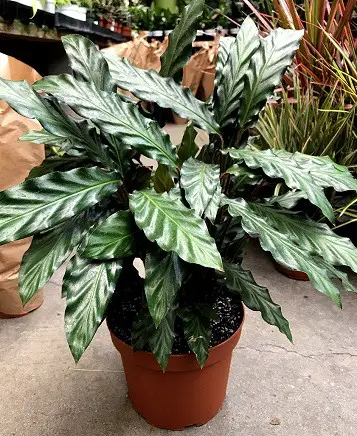
Rufibarba offers the prettiest indoor tropical appeal when compared to other calathea varieties in the market. The species is also known as furry feather or velvet calathea.
The calathea type hails from the Brazilian jungle. It has an upright clumping form with semi-glossy spear-shaped foliages that has green surfaces and burgundy undersides.
Each leaf is attached to a long burgundy stem. A mature rufibarba grows up to 2-3 feet tall and wide. It makes the plant ideal for both indoor and outdoor spaces.
Calathea rufibarba involves high humidity, well-draining potting soil, and a temperature range of 65-80oF. Keep this calathea type away from cold and heat drafts.
Grow the houseplant in bright indirect sunlight to enhance the leaf coloration and maximum utilization of water. Feed the houseplant with water-soluble fertilizer twice during spring.
You May Also Like: 25 Types of Peperomia With Pictures and Names
Calathea Roseoptica
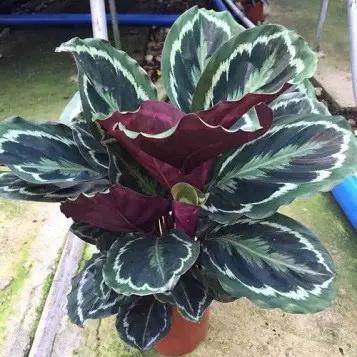
The species is also known as Rose Painted Calathea. The striking foliages and bright patterns are the reasons behind the Rose Painted name.
This kind of calathea has large oval and shiny foliages with green surfaces and purple undersides. The calathea species has an average height and width of 20-inches.
It also comes in several cultivars that differ in colors and patterns. It thrives in a temperature range of 65-80oF. Be sure to keep it away from cold and heat drafts.
Place the houseplant in bright indirect sunlight and stick to a strict watering regime to prevent root rot from occurring. Feed the plant with a water-soluble fertilizer every growing season.
You May Also Like: Calathea Leaves Turning Brown and How to Fix
Calathea Musaica
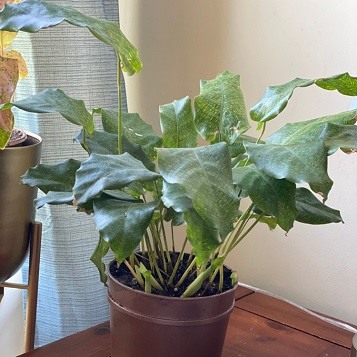
The calathea species is also known as Goeppertia Kegeljanii. This tropical plant is native to the Brazil rainforest. The species has the most beautiful foliages among the 70 calathea varieties.
The intricate and fine patterns on the leaves make this plant earns another name. Many Brazilians refer to it as Network Plant.
Musaica thrives in well-draining soil, moderate moisture level, high humidity, and temperature range of 60-85oF. Keep the plant away from heat and cold drafts.
I recommend feeding the plant twice or thrice every growing season with a water-soluble fertilizer. Too much salt around the root system might cause more damages.
You May Also Read: How to Care for Calathea Musaica Plant
Calathea Sanderiana
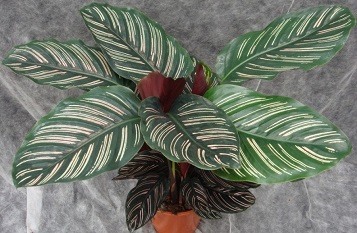
Sanderiana is a cultivar of calathea ornata. The species is also known as the Pin Stripe plant like the mother plant. The leaves on this species are more elliptical than spear-like.
The ornata cultivar adds tropical and colorful vibes to any space. Thanks to its large leathery and glossy foliages. It is the perfect option for growing in a living lounge and office space.
The leaf top has sport dark green with feathery pinstripe tinged in rose and cream. The undersides of the leaves are dark purple.
The leaves grow to about 2-feet long and half inches wide at maturity. Besides that, the foliages are attached to purple stems. Keep the plant away from drafts for successful growth.
Calathea Rosey

Rosey is a popular Roseoptica cultivar in many American homes. Thanks to its broad oval leaves bordered in green with cream and pink-colored centers.
The underside of the leaf is purple and the foliages tend to fold at night. A mature Rosey can grow up to 20 inches tall though smaller than roseoptica.
The striking colors make a bold statement in any indoor space. The Rosey care requirements are similar to that of calathea roseptica.
Calathea Dottie

Dottie is another popular calathea roseoptica cultivar. The calathea breed has large and glossy foliages similar to roseoptica in coloration and patterns.
But its eye-catching foliages with oval shape colored in deep greenish-black make the plant stand out from other cultivars. The leaf coloration is almost black from a distance.
Each leaf is bordered in bright with fuchsia pink. The color patterns stretch down the center of the leaf margin to look like another leaf.
The average height and width of the species are about 20 inches at maturity. The calathea Dottie care requirement is the same as the mother plant.
Calathea Fusion White
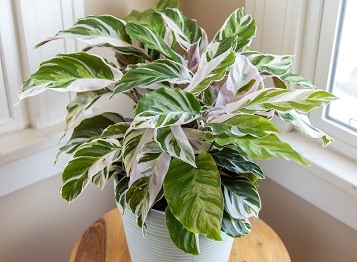
The species has a fantastic marbling of white and green on the leaves. The infusion of bright purple underside makes this houseplant popular in many homes.
The foliage coloration and compact size enable this calathea type to stand out from others. It is a perfect choice for growing in the office and living lounge.
The fusion white thrives in low to medium indirect sunlight, high humidity, well-draining soil, and a temperature range of 60-85oF. Be sure to keep the plant away from heat and cold drafts.
Calathea Albertii
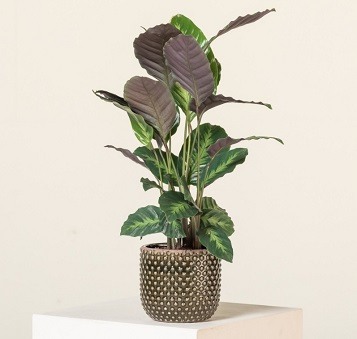
The calathea species is also known as the white tiger. Thanks to its striking white patterns on the dark green foliages that occur in a wavy form.
It also belongs to the low light calathea varieties list. The condition allows the species to develop stunning foliages. I recommend a short period of bright indirect sunlight early in the morning.
Besides that, keep the plant away from heat and cold drafts. Remember to feed the houseplant once or twice during the growing season using water-soluble fertilizer.
Calathea albertii care involves well-draining potting soil, high humidity, and a temperature range of 65-85oF. It is the best species to grow in hanging baskets (Check Best Deals on Amazon).
You May Also Read: How to Care for Mother of Thousands Plant
Final Word
Most species in this list do not belong to rare calathea varieties. It is one of the reasons behind the ease to grow and maintain at home or office.
Calathea identification is based on the foliage shape, texture, size, and coloration. These factors can help you tell the difference between various calathea types with ease.
Calathea care entails well-draining soil, high humidity, indirect sunlight, and a temperature range of about 60-85oF. Feed the plant twice during the growing season with a water-soluble fertilizer.
My favorite calathea type is Sanderiana (Check the Best Deals on Amazon) due to its striping foliages. The broad leathery and glossy leaves also add exciting tropical vibes in a space.
